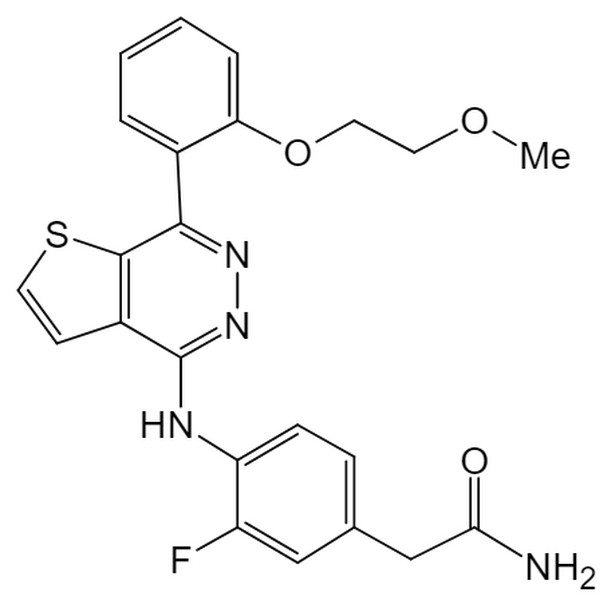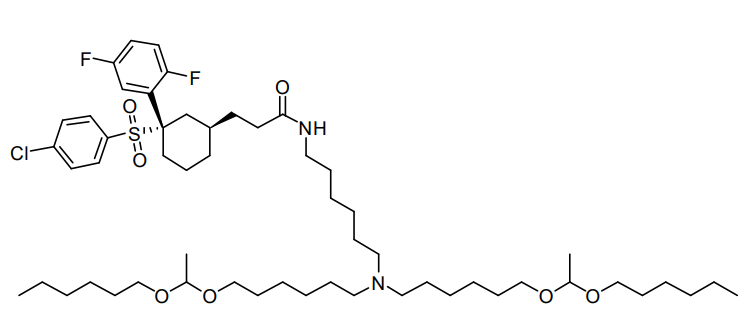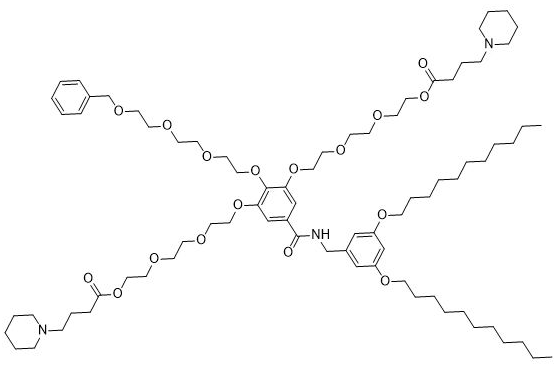| DC67569 |
Lipid S4
Featured
|
Lipid S4 is an advanced ionizable lipid engineered for systemic mRNA delivery to the brain, leveraging SR-57227—a high-affinity 5-HT3 receptor ligand—as its core head group to enable targeted blood-brain barrier (BBB) penetration via receptor-mediated transcytosis, while incorporating amino linkers for pH-responsive ionization and biodegradable branched ester tails to facilitate efficient endosomal escape and intracellular mRNA release; optimized through orthogonal screening into OS4 LNP (formulated at S4/DOPE/Chol/DMG-PEG2k = 40:40:60:0.75 molar ratio), it demonstrated a 13.3-fold increase in brain mRNA expression compared to FDA-approved MC3 LNPs, and further conjugation with the Tat cell-penetrating peptide yielded OS4T LNP, boosting delivery efficiency by 12.7-fold over OS4 alone and enabling broad mRNA expression across neurons, astrocytes, microglia, and endothelial cells; validated in orthotopic glioblastoma models, OS4T delivered engineered IL-12 mRNA, suppressing tumor growth and extending median survival to 37 days (vs. 17 days for controls) with minimal systemic toxicity, positioning S4-based LNPs as a robust, translatable platform for CNS-targeted therapeutics. |

|
| DC60864 |
D927 (DS11252927)
Featured
|
D927 is a molecular glue and promotes glucose uptake in the absence of insulin. D927 also increases the affinity of RAS binding to PI3Kα by ~500-fold. In vivo, D927 mimicks the effects of insulin and rapidly lowers blood glucose concentrations. |

|
| DC67295 |
Lipid MK16
Featured
|
MK-16 is a specialized lipid designed to traverse the blood-brain barrier (BBB) for effective mRNA delivery. Its formulation, MK 16 BLNP, leverages dual mechanisms involving caveolae and γ-secretase to facilitate BBB penetration, ensuring the targeted and efficient transport of functional mRNA to diverse brain cell types. Demonstrating excellent tolerability across a range of dosing regimens, MK16 BLNP represents a promising platform for brain-targeted therapeutic applications. |

|
| DC67292 |
IAJD34
Featured
|
IAJD-34 is a one-component ionizable amphiphilic Janus dendrimer specifically engineered for targeted mRNA delivery to the lung parenchyma, as described by Meshanni et al. in Nature Communications article "Targeted delivery of TGF-β mRNA to murine lung parenchyma using one-component ionizable amphiphilic Janus Dendrimers" . This synthetic nanoparticle self-assembles with mRNA through simple mixing in acetate buffer, forming stable dendrimersomes approximately 93-97 nm in size with high encapsulation efficiency (>95%) and a positive zeta potential (~48 mV). Its defining feature, highlighted in the study, is exceptional lung tropism after intravenous injection, enabling significantly higher luciferase expression in murine lungs compared to other organs. As demonstrated by Meshanni et al., IAJD 34 effectively delivers therapeutic mRNA (e.g., TGF-β mRNA) to the lower lung, inducing transient protein production with minimal systemic toxicity at appropriate doses (e.g., 10 µg), offering a promising strategy for treating parenchymal lung diseases. |

|
| DC67279 |
Rhobo6
Featured
|
Rhobo6 is a cell-impermeable small-molecule fluorophore designed for labeling the extracellular matrix (ECM) in live tissues. It contains a phenylboronic acid group that binds to diols commonly found in ECM glycans, resulting in a significant increase in fluorescence and a red shift in emission spectra. This property allows Rhobo6 to effectively visualize ECM architecture without perturbing native structures, making it suitable for long-term imaging studies. Additionally, Rhobo6's low affinity for monosaccharides enables reversible binding, which prevents photobleaching and allows for dynamic imaging of ECM components. While Rhobo6 does not specifically target individual ECM components, it provides a holistic view of ECM distribution and is particularly useful for studying ECM-related biological phenomena in samples that are not amenable to genetic manipulation or ex vivo culture.Rhobo6 is available under license from the Howard Hughes Medical Institute. |

|
| DC60676 |
MRT6160
Featured
|
MRT-6160 represents a groundbreaking molecular glue degrader designed to selectively target VAV1, achieving its proteasomal degradation with a DC50 value of 7 nM. This innovative compound showcases its unique mechanism and therapeutic potential. |

|
| DC60636 |
Acid-degradable Cationic Lipid (ADC)
Featured
|
Acid-degradable Cationic Lipid (ADC) composed of cationic lipid is synthesized with the azido-acetal linker and used to generate RD-LNPs, which significantly improves the performance of LNP-mRNA complexes in vitro and in vivo. |
.png)
|
| DC74503 |
KH-103
Featured
|
KH103 is a highly potent, catalytically-driven glucocorticoid receptor (GR) PROTAC degrader, demonstrate excellent performance in passively preventing ligand-induced gene expression activation in the absence of partial agonistic transcriptional triggering and crosstalk inhibition. KH 103 efficiently degrades glucocorticoid receptor (GR) in vitro and in vivo. In HEK293 cells, KH-103 (1 µM) induced rapid and nearly complete GR degradation within one hour. This degradation was highly potent, with significant depletion observed at 10 nM and near-complete depletion at 100 nM. KH-103 demonstrated effective and reversible GR degradation across diverse in vitro models from multiple tissues and species.Mechanistically, KH-103 promoted GR nuclear translocation but did not activate GR-mediated gene transcription and exhibited no nonspecific transcriptional effects alone. Furthermore, KH-103 effectively blocked dexamethasone (DEX)-induced GR signaling, demonstrating greater potency than comparator inhibitors.Critically, KH-103 also effectively depleted GR protein in the mouse pituitary gland in vivo and modulated corticosterone levels, confirming pharmacological activity beyond cell-based systems. |

|
| DC60559 |
PT-179
Featured
|
PT-179 is a novel orthogonal immunomodulatory drug (IMiD) derivative that selectively binds to CRBN without inducing degradation of off-target proteins. It demonstrates potent activity in degrading proteins fused to SD40, regardless of whether the fusion occurs at the N or C terminus. |

|
| DC60518 |
ACBI3
Featured
|
ACBI3 is a selective, potent and in vivo active pan-KRAS PROTAC degrader, potently degrades 13 out of 17 of the most prevalent oncogenic KRAS alleles (DC50=3.9 nM in GP2d cells). |

|
 To enhance service speed and avoid tariff delays, we've opened a US warehouse. All US orders ship directly from our US facility.
To enhance service speed and avoid tariff delays, we've opened a US warehouse. All US orders ship directly from our US facility.
















.png)


